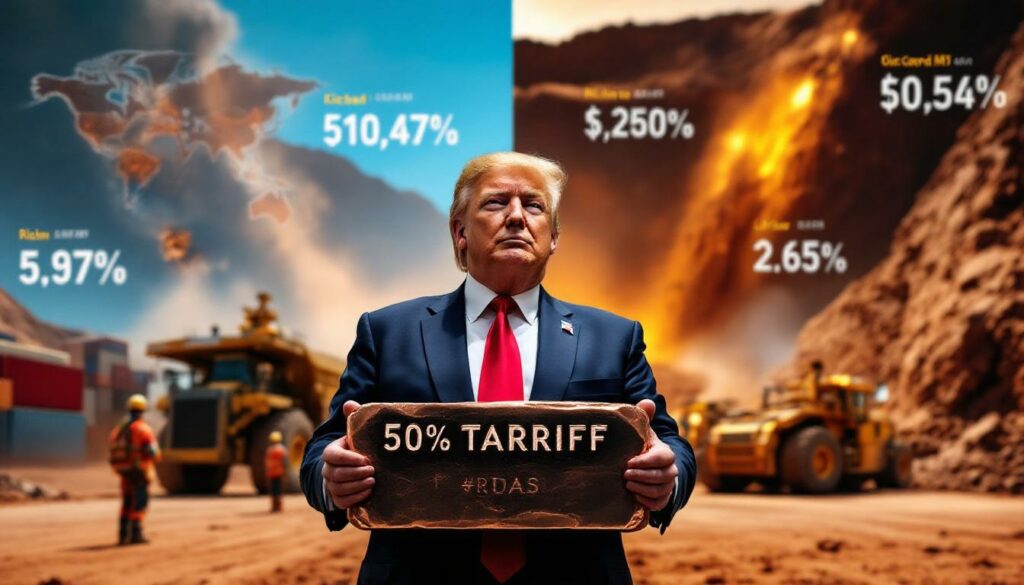Understanding Trump's Copper Tariff Announcement
President Trump's recent decision to implement a 50% tariff on copper imports represents one of the most significant trade policy shifts affecting the metals market in decades. Set to take effect on August 1, 2025, the tariff aims to revitalize domestic copper production and reduce dependence on foreign suppliers.
"The motivation behind the tariffs on copper is to encourage more domestic mining and smelting," notes Clyde Russell, Reuters columnist. "Copper is key to making electric vehicles, military hardware, semiconductors and consumer goods."
Despite the definitive announcement, several critical details remain unclear. The administration has yet to specify which copper products will fall under the tariff's scope or whether major suppliers like Chile and Canada might receive exemptions. This uncertainty has already created market volatility as industry participants scramble to understand the implications.
The Economic Rationale Behind the Decision
The administration views copper as strategically vital for America's industrial and military future. With applications spanning renewable energy infrastructure, defense systems, and advanced electronics, copper's importance in the green energy transition and technology manufacturing has elevated its status to that of a critical mineral.
The tariff policy aligns with Trump's broader "America First" economic vision, which prioritizes domestic manufacturing capabilities over globalized supply chains. By creating price incentives for U.S. production, the administration hopes to spark investment in domestic copper resources and processing facilities.
However, industry experts question whether tariffs alone can overcome the substantial challenges facing domestic copper expansion. The gap between policy announcement and production increases could span years, creating significant economic disruption in the interim.
Current State of US Copper Production
The United States currently faces a substantial copper supply deficit, producing only about half of its annual requirements. In 2024, U.S. refined copper imports reached 810,000 metric tons, highlighting the nation's significant dependence on foreign sources.
This supply-demand imbalance creates fundamental challenges for any policy aimed at copper self-sufficiency. According to Macquarie analysts, "U.S. refined copper imports reached 881,000 tons in the first half of 2025—double the underlying requirement of 441,000 tons," indicating substantial stockpiling ahead of the tariff implementation.
Existing US Copper Mining Operations
Major copper producers in the United States include Freeport McMoRan and Rio Tinto, who operate several mines primarily in western states like Arizona and Utah. Freeport's Morenci mine in Arizona stands as the largest copper producer in the country, but even combined, these operations cannot satisfy domestic demand.
The domestic copper industry has faced steady erosion over decades, with smelting capacity particularly diminished. Today, only three operational copper smelters remain in the United States, creating a severe processing bottleneck that limits the country's ability to convert mined ore into usable metal.
Most existing operations mine lower-grade deposits compared to international competitors, particularly those in Chile and Peru, where ore grades can be significantly higher. This geological disadvantage creates a structural cost challenge that tariffs may help offset but cannot eliminate.
Can US Copper Production Actually Increase?
The critical question facing policymakers and industry stakeholders is whether U.S. copper production can meaningfully increase in response to tariff incentives. The evidence suggests significant constraints on both short and medium-term growth potential.
Short-Term Production Limitations
Existing mines could potentially increase output temporarily by intensifying operations at current sites, but these gains would likely be marginal compared to the substantial import gap. Moreover, such increases often prove unsustainable, as they may accelerate depletion rates or require costly investments in additional equipment and labor.
The geological reality of U.S. copper deposits further constrains expansion potential. Unlike some global copper supply competitors with rich, near-surface deposits, many U.S. resources require deep underground mining with significant capital requirements and lengthy development timelines.
Smelting and Refining Capacity Constraints
Even if mining output increased, processing capacity represents a critical bottleneck. One potential approach—importing copper ore or concentrate for domestic refining—faces significant hurdles given limited U.S. smelting infrastructure.
The most promising candidate for additional smelting capacity appears to be the Grupo Mexico-owned Asarco plant in Arizona, which has been mothballed for over four years. However, reactivating this facility would require substantial investment and time, with industry experts estimating 18-24 months minimum before operations could resume.
Environmental permitting presents another major hurdle, as copper smelting involves significant emissions and waste management challenges. The regulatory approval process alone could extend the timeline for capacity expansion by years.
Long-Term Development Projects
The most significant potential new source of domestic copper is Rio Tinto's Resolution Copper project in Arizona. Despite a favorable Supreme Court ruling in May 2025 that resolved legal challenges from indigenous Apache groups, this project remains years away from production.
Resolution Copper exemplifies the lengthy timeline for new copper development. Despite containing one of North America's largest undeveloped copper deposits (estimated at 1.6 billion metric tons of ore), the project has been in permitting and development for over 15 years without producing a single pound of copper.
"Even with expedited permitting and development, Resolution Copper remains at least 5-7 years from commercial production," notes mining industry analyst John Thompson. "The infrastructure requirements alone—including shafts reaching 7,000 feet below surface—make this a decade-long undertaking."
Economic Impact of the Copper Tariffs
The implementation of copper tariffs will create immediate economic ripple effects across multiple sectors, with manufacturers facing difficult choices about how to absorb or pass on increased costs.
Price Effects on US Copper Markets
The tariff announcement has already triggered significant market distortions. U.S. copper contracts rose to a 26% premium over their London Metal Exchange (LME) equivalents immediately following Trump's announcement, up from a 13% premium previously.
As of July 10, 2025, benchmark LME copper contracts were trading at $9,630.50 per ton, representing a 10% increase since the end of 2024. This suggests the market had already begun pricing in potential trade action even before the formal announcement.
Interestingly, the current premium remains below the full 50% tariff level, suggesting market uncertainty about final implementation details or expectations of eventual exemptions for key suppliers.
Cost Implications for US Manufacturers
U.S. manufacturers face difficult options: pay substantially higher prices for copper inputs, reduce copper usage through redesign, or absorb the cost increases through reduced margins. Industries particularly affected include:
-
Automotive manufacturing: Electric vehicles require 2-4 times more copper than conventional vehicles, with an average EV containing about 180 pounds of copper. The Center for Automotive Research estimates copper tariffs could add approximately $200 to vehicle production costs.
-
Construction: Building wiring, plumbing systems, and HVAC equipment all rely heavily on copper, potentially increasing housing and commercial building costs.
-
Electronics production: Circuit boards, semiconductors, and connectivity components all require high-purity copper, affecting everything from smartphones to data centers.
-
Utility infrastructure: Power generation, transmission, and distribution systems are copper-intensive, potentially impacting grid modernization efforts.
"Companies that use copper as an input face a difficult choice: pay the higher price or find ways to use less of the metal," explains Russell. "Neither option is particularly appealing."
Inflation and Cost Absorption Concerns
The broader economic impact depends largely on how manufacturers respond to higher input costs. If costs are passed to consumers, the tariffs could contribute to inflationary pressure. If companies absorb the costs—as suggested by the administration—it may reduce capital investment, employment, or shareholder returns.
A Peterson Institute study of the 2018 steel tariffs found they cost U.S. manufacturers approximately $1.4 billion monthly in higher input costs, while creating fewer jobs in steel production than were lost in steel-consuming industries.
Global Market Disruptions
The tariff announcement has already triggered significant disruptions in global copper flows and trading patterns, with further adjustments likely as implementation approaches.
Short-Term Market Distortions
According to Macquarie analysis, the United States has imported approximately 881,000 tons of copper in the first half of 2025, far exceeding its underlying requirement of roughly 441,000 tons. This abnormal volume strongly suggests widespread stockpiling ahead of the tariff implementation.
This stockpiling behavior creates artificial demand that temporarily supports global prices while potentially setting up a sharp demand drop once the tariffs take effect. As one trader noted anonymously, "We're seeing customers requesting six months of supply delivered in six weeks."
The regional price differential has also created arbitrage opportunities for traders who can secure copper before the tariff date, creating additional market distortions.
Long-Term Price and Supply Chain Shifts
Once implemented, U.S. imports are expected to plunge as stockpiled copper is consumed. This could temporarily depress global copper prices, reversing the upward trend seen since Trump's return to office.
The market may ultimately develop a two-tier pricing structure, with U.S. domestic prices consistently trading at a premium to global benchmarks. This price differential will likely reshape global copper flows:
- Chilean and Peruvian exports may increasingly target Asian markets
- Canadian producers may prioritize U.S. shipments if exempted from tariffs
- Copper-intensive manufacturing may gradually shift offshore to access lower-cost inputs
Global trading patterns will also adjust. Some market analysts predict "tariff circumvention" strategies might emerge, such as shipping copper through potentially exempted countries or in modified forms that avoid tariff classifications.
Industry Responses to the Tariff Policy
Different industry segments are developing distinct strategies to navigate the new tariff environment, with varying degrees of adaptation flexibility.
Mining Company Strategies
Some mining companies have expressed cautious optimism about the tariff policy. Rio Tinto has indicated interest in expanding U.S. copper operations, potentially accelerating development timelines for projects like Resolution Copper if market conditions remain favorable.
However, mining executives emphasize that tariffs alone cannot overcome fundamental constraints:
- Geological realities: U.S. copper deposits generally feature lower grades than international competitors
- Permitting timelines: New mine approvals typically require 7-10 years in the U.S. regulatory environment
- Capital requirements: New copper mines require billions in upfront investment before producing revenue
Smaller domestic producers may benefit more immediately, with operations that were marginally profitable potentially seeing improved economics under tariff protection.
Manufacturer Adaptation Approaches
U.S. manufacturers dependent on copper inputs are exploring various strategies to mitigate cost increases:
- Accelerated purchasing: Building inventory before tariff implementation
- Material substitution: Replacing copper with alternatives where technically feasible
- Design optimization: Reducing copper content through engineering redesign
- Supply chain restructuring: Relocating production or sourcing finished components
- Price adjustments: Passing increased costs to customers where market power permits
Ford's engineering teams, for example, have already redesigned wiring harnesses in the F-150 Lightning to reduce copper content by approximately 15%, though such redesigns require significant lead time and engineering resources.
"Manufacturers are getting creative, but there are physical limits to how much copper can be engineered out of products while maintaining performance," notes materials science professor Maria Rodriguez.
Will the Tariffs Achieve Their Intended Goals?
The fundamental question surrounding the tariff policy is whether it will ultimately achieve its stated objective of increasing domestic copper production and enhancing U.S. self-sufficiency.
Realistic Production Growth Potential
The most significant challenge facing the policy's effectiveness is the substantial time lag between tariff implementation and any meaningful increase in domestic copper production. This creates an extended period where U.S. manufacturers face higher input costs without corresponding domestic supply increases.
New copper mines typically require:
- 2-3 years for exploration and resource definition
- 2-3 years for feasibility studies and engineering
- 2-4 years for permitting and environmental reviews
- 2-3 years for construction and commissioning
This 8-13 year timeline from discovery to production creates a fundamental mismatch between policy implementation and supply response. Even accelerating existing projects like Resolution Copper would likely require 5+ years before first production.
The U.S. Geological Survey estimates U.S. copper reserves at approximately 48 million metric tons—theoretically sufficient for decades of production—but converting these geological resources into economically viable mines remains challenging even with tariff support.
Trade-offs Between Protection and Competitiveness
While the tariffs may eventually stimulate some additional domestic copper production, they create immediate competitive disadvantages for U.S. manufacturers who use copper as an input. This raises questions about the net economic benefit of the policy.
The tariffs effectively represent a transfer from copper-consuming industries (which employ millions) to copper-producing companies (which employ thousands). This imbalance creates potential efficiency losses for the broader economy.
Historical experience with similar policies suggests mixed results. The 2018 steel tariffs increased domestic steel production modestly but created substantial downstream costs for steel-consuming industries. Some economists argue these costs exceeded the benefits to domestic steel producers by a significant margin.
FAQ: Trump's Copper Tariffs
How much copper does the US currently import?
The U.S. imported 810,000 metric tons of refined copper in 2024 and approximately 881,000 tons in just the first half of 2025, according to Macquarie analysts. This represents roughly half of annual U.S. consumption, highlighting the substantial gap that domestic production would need to fill to achieve self-sufficiency.
Which countries supply most of the US copper imports?
Major suppliers include Chile, Canada, and Peru. Chile alone accounts for approximately 35% of U.S. copper imports, followed by Canada (18%) and Peru (12%). The tariff announcement did not specify whether any countries would receive exemptions, though trade agreements like USMCA (with Canada and Mexico) could potentially provide grounds for exemption requests.
How have copper prices responded to the tariff announcement?
U.S. copper contracts rose to a 26% premium over London equivalents immediately following the announcement, up from a 13% premium previously. Benchmark London copper contracts were trading at $9,630.50 per ton as of July 10, 2025. The market reaction suggests significant concern about supply disruptions and cost increases, though the premium remains below the full 50% tariff level, indicating uncertainty about implementation details.
When will the copper tariffs take effect?
The tariffs are scheduled to become effective on August 1, 2025, though final implementation details may still be subject to change. The administration has not yet published comprehensive guidelines on product classifications, potential exemptions, or application procedures for exclusion requests.
Future Outlook for US Copper Markets
The implementation of copper tariffs marks the beginning of a significant transition period for U.S. copper markets, with both short and long-term implications for prices, supply chains, and industrial competitiveness.
Price Projection Scenarios
Once implementation details are clarified and existing stockpiles are depleted, U.S. copper prices are likely to stabilize at a premium that reflects the final tariff level. This could create a two-tier global copper market with significantly higher prices in the U.S.
Market analysts project three potential scenarios for U.S. copper prices post-implementation:
- Full tariff reflection: U.S. prices stabilize at approximately 50% above global benchmarks, representing the complete tariff pass-through
- Partial absorption: U.S. prices settle 30-40% above global benchmarks as importers absorb some costs to maintain market share
- Exemption-moderated: If major suppliers receive exemptions, U.S. premiums might stabilize at 15-25% above global benchmarks
The price differential will likely vary by product category, with high-purity copper products potentially seeing larger premiums due to limited domestic alternatives.
Long-Term Supply Chain Restructuring
The persistent price differential may eventually drive structural changes in global copper supply chains, potentially including:
- Increased investment in U.S. copper exploration and development: Higher sustained prices could make marginal deposits economically viable, particularly in Arizona, Nevada, and Utah
- Expanded recycling capacity: Secondary copper recovery could increase from current levels (~30% of U.S. supply) as price incentives improve economics
- Manufacturing relocation: Copper-intensive production may gradually shift to countries with lower input costs, particularly for export-oriented products
- Material substitution R&D: Higher copper prices could accelerate research into alternatives like aluminum alloys or carbon nanotube conductors where technically feasible
"The market will eventually adapt to the new reality, but the transition period will be challenging for many industries," notes economist Michael Chen. "We're likely to see a complex reshuffling of global copper flows before a new equilibrium emerges."
While the tariffs may ultimately succeed in increasing domestic copper production, the long timeline for mining development ensures that any supply response will lag significantly behind the immediate price impacts. This timing mismatch creates both challenges and opportunities for various market participants as they navigate an unprecedented restructuring of U.S. copper markets.
The potential for a copper price collapse outside the U.S. remains a concern for global producers, while surging copper demand within the green energy sector further complicates the market outlook. For investors, the changing landscape has sparked interest in [copper-uranium investments](
Ready to Capitalise on the Next Major Mineral Discovery?
Stay ahead of the market with Discovery Alert's proprietary Discovery IQ model, delivering instant notifications on significant ASX mineral discoveries and transforming complex data into actionable insights. Explore how major mineral discoveries can lead to exceptional returns by visiting the Discovery Alert discoveries page and begin your 30-day free trial today.




